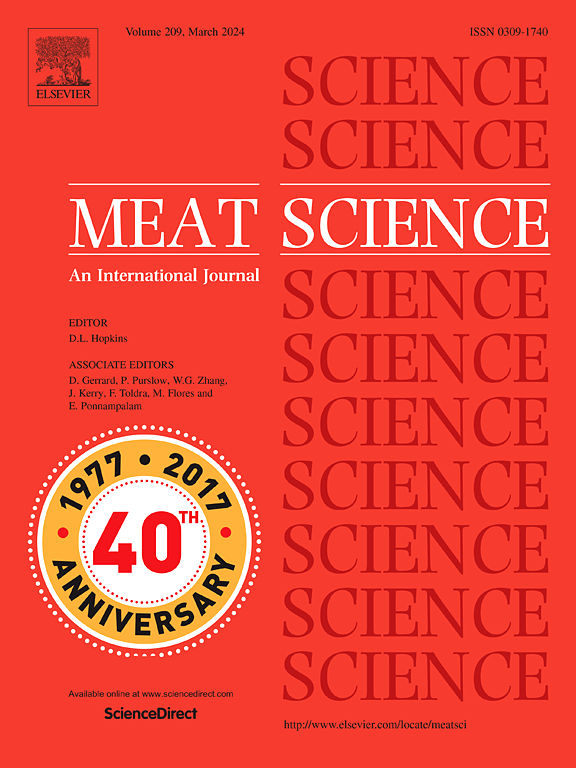采用不同饲养期的内洛尔阉牛的生产性能、肌肉代谢物和牛肉质量
IF 6.1
1区 农林科学
Q1 Agricultural and Biological Sciences
引用次数: 0
摘要
本研究评价了不同育肥期Nellore淘汰奶牛的生产性能、肌肉代谢产物和牛肉品质。选取初始体重为477.4±49.6 kg的Nellore奶牛20头,随机分为3个处理:6头为对照组(D0), 7头为育肥期28 d (D28), 7头为育肥期56 d (D56)。测定不同老化时间(0、7、14AT)的干物质采食量、收缩体重、空体重、热胴体重、胴体收缩率、肌肉代谢物和肉质参数。D28和D56处理的扑杀奶牛EBW (P <;0.001)比D0。然而,与D0和D28处理相比,只有D56处理的HCW (P = 0.004)和背部脂肪厚度(P = 0.005)更大。结果表明,D56处理的胴体pH值低于D0和D28处理(P = 0.002)。饲喂28和56 d的精选牛腰最长肌中糖(葡萄糖-6-磷酸和果糖-6-磷酸)、甘油和氨基酸(亮氨酸、丙氨酸、异亮氨酸、缬氨酸和天冬氨酸)含量较高。综上所述,随着育肥期和老化时间的延长,脂肪含量和肉嫩度分别有相应的提高。本文章由计算机程序翻译,如有差异,请以英文原文为准。
Performance, muscle metabolites, and beef quality of Nellore cull cows subjected to different finishing feeding durations
This study evaluated the performance, muscle metabolites, and beef quality of Nellore cull cows subjected to different finishing feeding durations. Twenty Nellore cows (initial body weight of 477.4 ± 49.6 kg) were randomly assigned to the three treatments: six as the control group (D0), seven finishing-fed for 28 d (D28), and seven finishing-fed for 56 d (D56). Parameters including dry matter intake, shrunk body weight, empty body weight (EBW), hot carcass weight (HCW), carcass shrinkage, muscle metabolites, and meat quality parameters in different aging times (0AT, 7AT, and 14AT) were assessed. Cull cows subjected to D28 and D56 treatments had greater EBW (P < 0.001) than D0. However, greater HCW (P = 0.004) and back fat thickness (P = 0.005) were detected in only D56 treatment compared to D0 and D28 treatments. As a result, the carcass pH was lower in the D56 treatment (P = 0.002) compared to D0 and D28 treatments. The Longissimus lumborum muscle of cull cows finished for 28 and 56 d showed a higher concentration of sugars (glucose-6-phosphate and fructose-6-phosphate), glycerol, and amino acids (leucine, alanine, isoleucine, valine, and aspartate). In conclusion, as the finishing period and aging time increased, there was a corresponding improvement in fat content and meat tenderness, respectively.
求助全文
通过发布文献求助,成功后即可免费获取论文全文。
去求助
来源期刊

Meat Science
工程技术-食品科技
CiteScore
12.60
自引率
9.90%
发文量
282
审稿时长
60 days
期刊介绍:
The aim of Meat Science is to serve as a suitable platform for the dissemination of interdisciplinary and international knowledge on all factors influencing the properties of meat. While the journal primarily focuses on the flesh of mammals, contributions related to poultry will be considered if they enhance the overall understanding of the relationship between muscle nature and meat quality post mortem. Additionally, papers on large birds (e.g., emus, ostriches) as well as wild-captured mammals and crocodiles will be welcomed.
 求助内容:
求助内容: 应助结果提醒方式:
应助结果提醒方式:


